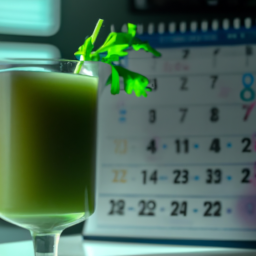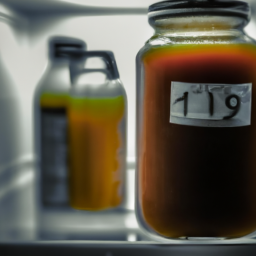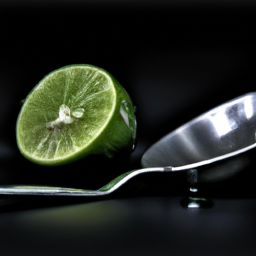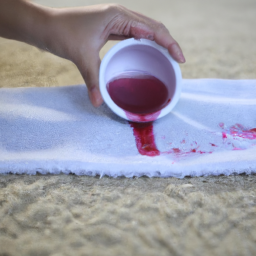You might be under the impression that juice from a lemon squeezed directly from the fruit can’t be matched by the bottled variety. And indeed, you are correct; the two are not identical. However, there are times when ease of use takes precedence, leading us to choose the pre-bottled option. The real inquiry then becomes, what is the shelf life of this bottled lemon juice in either your pantry or refrigerator?
Bottled lemon juice is a handy ingredient to have on hand for cooking, baking, and even cocktails. But unlike fresh lemon juice, which can last up to a week in the fridge, bottled lemon juice has a much longer shelf life. However, it’s important to know just how long it’s good for and how to properly store it to ensure it stays fresh and safe to use.
In this article, we’ll explore the shelf life of bottled lemon juice, how to store it, and some tips for using it in your cooking.
Key Takeaways
- Bottled lemon juice has a longer shelf life than fresh lemon juice, up to 6 months if stored properly.
- Proper storage conditions include refrigeration and using glass containers.
- Freezing can extend the shelf life up to 6 months.
- Check expiration dates on the label and discard if expired to avoid bacterial growth and loss of flavor and nutrients.
The Shelf Life of Bottled Lemon Juice
You might be wondering how long your bottled lemon juice lasts, but don’t worry, it typically stays fresh for up to six months if stored properly. However, it’s important to note that the six-month shelf life is an estimate, and the exact duration can vary depending on factors such as the brand of lemon juice, the storage conditions, and the expiration date.
If you’re unsure whether your bottled lemon juice is still good, check the expiration date on the label. If the date has passed, it’s best to discard the juice. But if the expiration date hasn’t arrived yet and you’re still wary about the juice’s freshness, you can do a simple sensory test. Smell the lemon juice and if it has an off odor or taste, it’s time to get rid of it. However, don’t just throw it away there are plenty of uses for expired lemon juice, such as cleaning and cooking.
Now that we’ve covered how long bottled lemon juice typically lasts, let’s talk about how to store it to ensure its longevity.
How to Store Bottled Lemon Juice
When it comes to storing bottled lemon juice, there are a few key factors to consider. First and foremost, refrigeration is essential to maintaining freshness and preventing spoilage.
Additionally, freezing can be a viable option for extending the shelf life of lemon juice. Finally, selecting the proper container can help to preserve the flavor and quality of the juice over time.
Refrigeration
If you’re storing bottled lemon juice, it’s best to keep it refrigerated to maintain its freshness for as long as possible. While bottled lemon juice typically has preservatives to extend its shelf life, refrigeration can still prolong its quality. This is especially important if you want to enjoy the benefits of using fresh lemons, such as their high vitamin C content and natural flavor. Using bottled lemon juice may have its disadvantages, such as a less vibrant taste and potential exposure to chemicals from the plastic container, but refrigeration can help mitigate some of these issues.
To give you a better idea of how long bottled lemon juice can last in the fridge, here’s a table outlining its approximate shelf life:
| Type of Lemon Juice | Opened | Unopened |
|---|---|---|
| Concentrate | 6 months | 12 months |
| Ready-to-use | 6 months | 12 months |
It’s important to note that these timeframes are only estimates and may vary depending on the brand and storage conditions. To ensure the best quality, always check the expiration date on the bottle and follow proper storage guidelines. Now, let’s move on to the next section and discuss how freezing bottled lemon juice can impact its shelf life.
Freezing
Freezing bottled lemon juice can affect its quality and taste, so it’s important to consider the pros and cons before deciding to freeze it. When using frozen lemon juice for cooking, it’s important to note that the flavor may not be as fresh as using fresh lemon juice.
However, freezing lemon juice can be a great way to extend the shelf life of the juice, especially if you don’t use it frequently. One of the benefits of freezing lemon juice is that it can be stored for up to 6 months in the freezer. This means that you can always have lemon juice on hand for recipes that call for it, without worrying about it going bad.
Just be sure to store it in an airtight container to prevent freezer burn. Using frozen lemon juice can also be a time saver, as you won’t need to worry about squeezing fresh lemons every time you need lemon juice. When it comes to proper container selection for frozen lemon juice, it’s important to choose a container that is freezer safe and airtight.
This will prevent any air from getting in and causing freezer burn, which can affect the taste of the juice. Additionally, using a container that is the appropriate size for the amount of lemon juice being frozen can minimize the amount of air in the container. With these considerations in mind, freezing bottled lemon juice can be a great way to extend its shelf life and have it on hand for all your cooking needs.
Proper Container Selection
To ensure your frozen lemon juice stays fresh, you’ll want to select a suitable container that seals tightly, preventing any air from spoiling the taste over time. When it comes to choosing the right container, glass bottles are the best option as they do not interact with the acidic content of lemon juice, preserving its flavor and quality for an extended period. While plastic containers are a convenient and lightweight option, they may not be suitable for storing lemon juice for an extended period. Plastic containers may not be tolerant to the high acidity content in the lemon juice, which could lead to the leaching of chemicals into the lemon juice, altering its taste and quality.
To emphasize the benefits of using glass containers for storing lemon juice, here is a table comparing the pros and cons of glass and plastic containers.
| Container Type | Benefits | Drawbacks |
|---|---|---|
| Glass | Preserves flavor and quality, does not interact with acidic content | Heavy, may break easily |
| Plastic | Convenient, lightweight | May leach chemicals into acidic content, not suitable for long-term storage |
When it comes to storing lemon juice, choosing the right container can make a significant difference in preserving its quality and taste. Now that you know how to select the right container for storing your lemon juice, let’s move on to some tips for using bottled lemon juice.
Tips for Using Bottled Lemon Juice
When you’re using bottled lemon juice, there are a few tips that can help you get the most out of this ingredient. One of the benefits of using bottled lemon juice is that it’s much more convenient than fresh lemons. You don’t have to worry about squeezing or juicing the lemons, which can be time-consuming and messy.
Additionally, bottled lemon juice has a longer shelf life than fresh lemons, so you don’t have to worry about it going bad quickly. When choosing the best brand of bottled lemon juice, look for options that are made from 100% lemon juice with no added sugars or preservatives. Some brands may also have a stronger or more concentrated flavor, so consider your personal preferences when making your selection.
Now that you know how to use bottled lemon juice, let’s explore some alternatives to this ingredient.
Alternatives to Bottled Lemon Juice
If you’re tired of settling for bland and lackluster flavors, there are plenty of zesty alternatives to the typical bottled lemon juice.
One of the best lemon juice substitutes is fresh lemon juice. Not only does it have a brighter, more vibrant flavor than bottled juice, but it also has a host of health benefits. Fresh lemon juice is high in vitamin C, antioxidants, and can even aid in digestion.
Another alternative to bottled lemon juice is using other citrus juices, such as lime or grapefruit. These juices can add a unique flavor to dishes and provide similar health benefits as lemon juice. Additionally, using vinegar or white wine in place of lemon juice can provide a tangy flavor without the risk of the juice going bad.
With these lemon juice substitutes, there’s no need to settle for bland flavors in your cooking.
When it comes to recipes that use bottled lemon juice, there are plenty of options available. From salad dressings to marinades to baked goods, bottled lemon juice can add a zesty kick to any dish.
However, if you’re looking to elevate your cooking game and add some fresh, vibrant flavors to your dishes, trying out some of the alternatives mentioned above can take your meals to the next level.
Recipes that Use Bottled Lemon Juice
So, let’s talk about some recipes that use bottled lemon juice.
Salad dressings, marinades, and desserts are just a few examples of dishes that can benefit from the addition of this versatile ingredient.
But what about storing and using bottled lemon juice? Can you freeze it? And what happens if you use expired juice?
Let’s explore these questions and more in this subtopic.
Salad Dressings
To make your salad dressings last longer, you should consider using bottled lemon juice instead of fresh lemons. Not only does bottled lemon juice have a longer shelf life, but it also has consistent acidity levels that can help keep your dressings from spoiling too quickly.
Here are three reasons why bottled lemon juice is a great choice for salad dressings:
-
Creative uses: Bottled lemon juice isn’t just for salad dressings. You can also use it to make marinades, sauces, and even cocktails. Its versatility makes it a great addition to any kitchen.
-
Health benefits: Lemon juice is packed with vitamin C and antioxidants, which can help boost your immune system and promote healthy skin. It’s also a natural detoxifier that can help cleanse your body of harmful toxins.
-
Consistent flavor: One of the biggest advantages of using bottled lemon juice is the consistent flavor it provides. Fresh lemons can vary in acidity and sweetness, which can affect the overall taste of your dressing. Bottled lemon juice, on the other hand, provides a reliable and consistent flavor profile.
Transitioning into the next section about marinades, it’s important to note that bottled lemon juice can also be a great choice for marinades. By using bottled juice, you can ensure that your marinade has a consistent acidity level that can help tenderize meat and infuse it with flavor.
Marinades
Using marinades can add depth and flavor to your meats. And while some may worry about the added calories, incorporating healthier ingredients like herbs and spices can make for a nutritious and delicious meal. Marinades are mixtures of oil, acid, and flavorings that are used to tenderize and flavor meats.
The acid in the marinade breaks down the proteins in the meat, making it more tender, while the oil and flavorings infuse it with delicious flavors. Marinade recipes can vary greatly, depending on the type of meat and the desired flavor profile. Some popular ingredients for marinades include citrus juices, vinegar, soy sauce, garlic, and herbs like rosemary and thyme.
Marinating times can also vary, with tougher cuts of meat requiring longer marinating times. The benefits of marinating are many, from enhancing flavor to improving texture, and it’s a great way to add variety to your meals.
Speaking of variety, let’s move onto the next topic: desserts.
Desserts
Indulging in a sweet treat after a meal can be a satisfying way to end the day, and with endless possibilities for desserts, there’s always something new to try. If you’re a fan of tangy and refreshing flavors, then lemon flavored desserts might just be your new favorite. One of my go-to recipes is lemon curd, which can be used as a filling for cakes, tarts, and even spread on toast for a quick snack.
To make lemon curd, you’ll need fresh lemon juice, but if you’re short on time, bottled lemon juice can be a convenient substitute. However, it’s important to check the expiration date and storage recommendations on the bottle to ensure the quality and safety of the juice. According to most manufacturers, bottled lemon juice can last up to 18 months if stored properly in the refrigerator after opening. Here’s a table summarizing the shelf life of bottled lemon juice:
| STORAGE CONDITION | SHELF LIFE |
|---|---|
| Unopened bottle | Up to 2 years |
| Opened bottle in pantry | Up to 1 year |
| Opened bottle in fridge | Up to 6 months |
If you’re looking for more lemon curd recipes or other lemon flavored desserts, there are plenty of options available online or in cookbooks. Just make sure to use fresh, high-quality ingredients for the best results. Now, let’s move on to the next topic: can you freeze bottled lemon juice?
Can You Freeze Bottled Lemon Juice?
Freezing lemon juice in a small plastic bag is a great way to preserve its citrusy flavor. However, there are some precautions that you need to take to ensure that the juice stays fresh.
Before freezing the lemon juice, make sure that it’s in an airtight container and that there’s enough room for the juice to expand as it freezes. You can also add a little bit of sugar or salt to help preserve the flavor.
When it comes to thawing the lemon juice, there are a few methods that you can use. One option is to place the frozen bag in the fridge overnight. This’ll allow the juice to thaw slowly and prevent it from losing its flavor. Another option is to place the bag in a bowl of warm water for a few minutes. Just be sure not to use hot water, as this can cause the bag to burst.
By taking these precautions and using the proper thawing methods, you can enjoy the fresh taste of lemon juice in your recipes for up to six months.
As for using expired bottled lemon juice, there are some risks involved. While the juice may still be safe to consume, it may have lost some of its flavor and nutrients over time. In addition, there’s a risk of bacterial growth, which can cause foodborne illness.
If you’re unsure about the safety of your expired lemon juice, it’s best to err on the side of caution and discard it.
Can You Use Expired Bottled Lemon Juice?
Expired bottled lemon juice may not be suitable for consumption due to potential loss of flavor and nutrients and the risk of bacterial growth. Using expired lemon juice can also lead to health risks such as stomach upset, food poisoning, and other related illnesses.
Here are some important things to consider before using expired bottled lemon juice:
- Check the expiration date on the bottle before using it.
- If the bottle has been opened for a long time, it may have gone bad even if it hasn’t expired yet.
- If the juice has a strange smell or taste, it’s best to discard it.
- Using expired lemon juice in recipes can affect the taste of the dish.
It’s always better to use fresh lemon juice for optimal flavor and nutritional value. It’s important to note that bottled lemon juice, whether expired or not, may not be as good as fresh lemon juice. The freshness of the juice can impact the taste and nutritional value of the juice.
In the next section, we’ll discuss whether bottled lemon juice is as good as fresh.
Is Bottled Lemon Juice as Good as Fresh?
Savoring the tangy zing of freshly squeezed lemon juice elevates the taste and quality of dishes compared to its store-bought counterpart. However, using bottled lemon juice also has its benefits.
Bottled lemon juice is convenient and can last for a longer time compared to fresh lemons. It’s also consistent in terms of acidity level, ensuring that your dishes have the right balance of flavors.
When comparing bottled lemon juice with other bottled citrus juices, bottled lemon juice stands out in terms of versatility. It can be used in a wide range of dishes, from savory to sweet. Its flavor also blends well with other ingredients, making it a staple in many kitchens.
Overall, while fresh lemon juice may be ideal in certain situations, bottled lemon juice is a reliable and convenient alternative that can elevate the taste of your dishes.
Frequently Asked Questions
Can I use bottled lemon juice for baking?
As the adage goes, "when life gives you bottled lemon juice, use it for baking."Baking with bottled lemon juice is possible, but be aware of flavor differences compared to fresh lemon juice.
Is bottled lemon juice pasteurized?
Yes, bottled lemon juice is usually pasteurized, providing benefits such as increased shelf stability and reduced risk of bacterial contamination. This process involves heating the juice to kill harmful microorganisms without affecting its flavor or nutritional value.
How long does freshly squeezed lemon juice last compared to bottled lemon juice?
Did you know that freshly squeezed lemon juice contains up to 5 times more Vitamin C than bottled lemon juice? In terms of flavor differences, fresh lemon juice has a brighter, more vibrant taste compared to the slightly dull taste of bottled lemon juice.
Are there any health benefits to using bottled lemon juice?
I have found that bottled lemon juice may not provide the same health benefits as freshly squeezed lemon juice. However, it can still be used in lemon juice cleansing and weight loss regimens.
Can I freeze bottled lemon juice to extend its shelf life?
Yes, you can freeze bottled lemon juice to extend its shelf life. Freezing prevents bacteria growth and oxidation, maintaining the juice’s quality for up to 6 months. Thaw in the fridge before using.
Conclusion
In conclusion, bottled lemon juice is a convenient and versatile ingredient that can be used in a variety of recipes. However, it’s important to keep in mind that the shelf life of bottled lemon juice varies depending on the brand and storage method. On average, bottled lemon juice can last up to six months in the refrigerator.
Interestingly, a study conducted by the United States Department of Agriculture found that bottled lemon juice can contain more vitamin C than fresh lemon juice. This is because bottled lemon juice is often made from the juice of high-quality lemons that are harvested at their peak, while fresh lemons may have varying levels of vitamin C depending on the ripeness and quality of the fruit.
So, when it comes to getting your daily dose of vitamin C, bottled lemon juice may be a more reliable source than fresh lemons. Remember to always check the expiration date and storage instructions on your bottled lemon juice to ensure its freshness and quality.
Ilana has been a vegan for over 10 years. She originally made the switch for health reasons, but soon found herself becoming more and more passionate about the ethical and environmental implications of a vegan lifestyle. Ilana is the author of The Graceful Kitchen, a blog all about veganism. She loves to cook up delicious and nutritious vegan meals, and share her recipes with others who are interested in leading a cruelty-free life. Ilana is also a strong advocate for using whole foods as the foundation of a healthy diet, and believes that going vegan is one of the best ways to achieve this.










